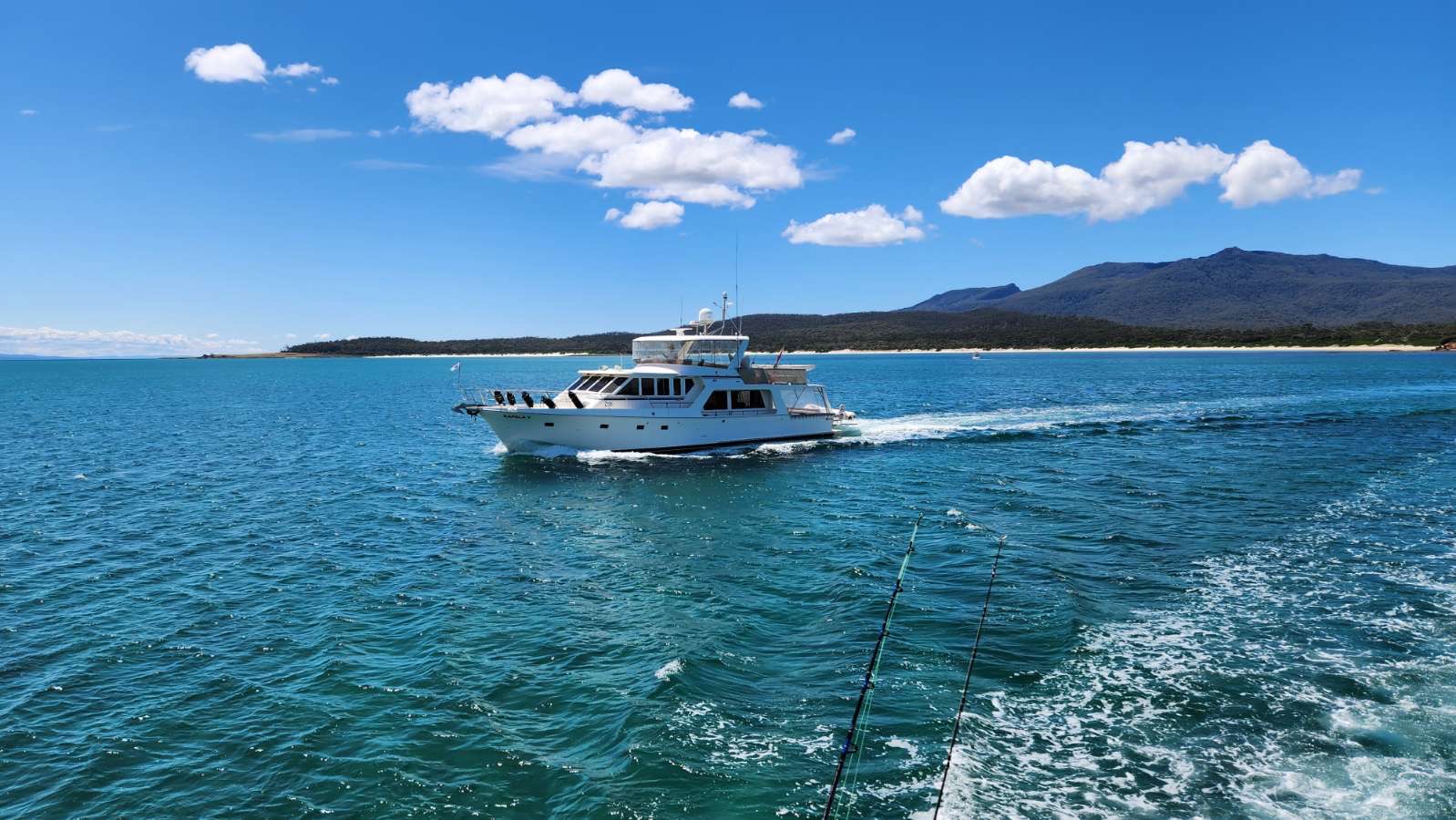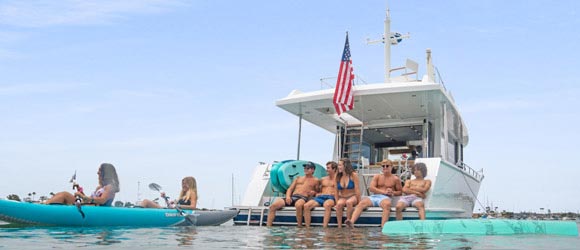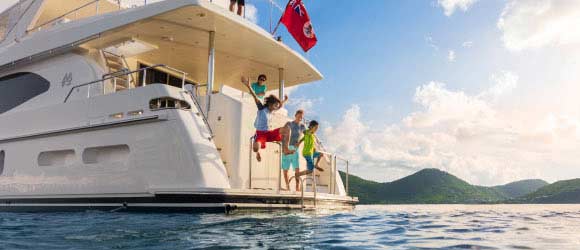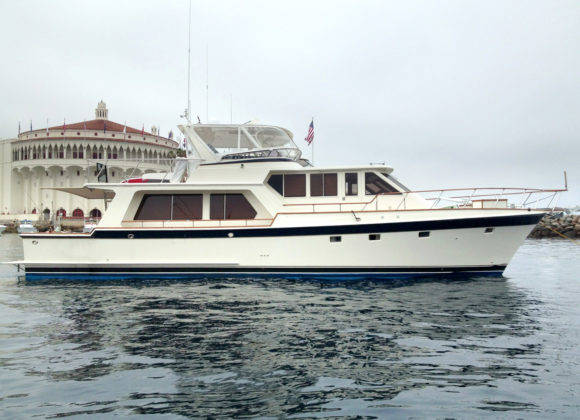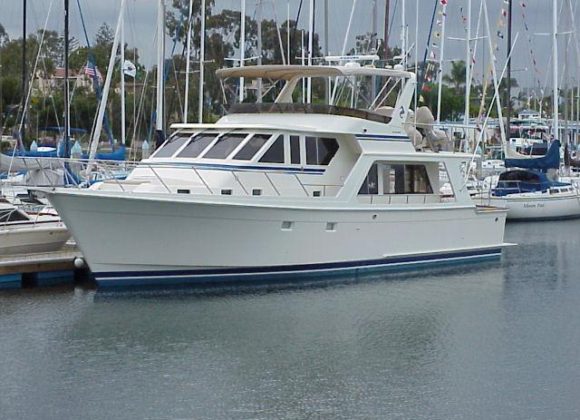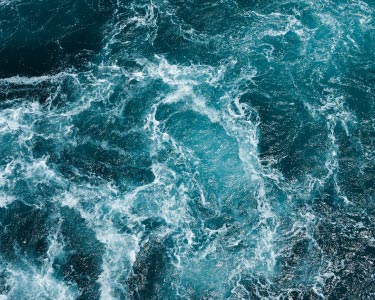

New yachts
Featured listings
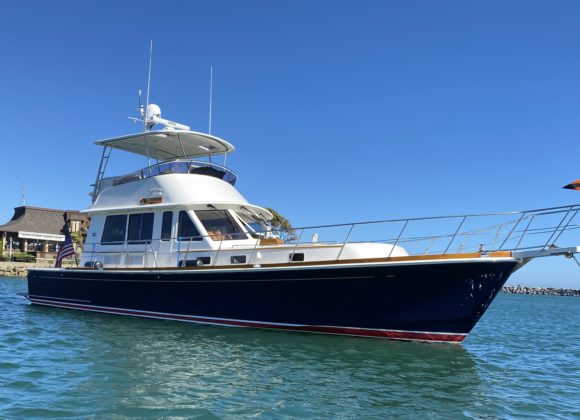 new listing
new listing
2005 47′ Grand Banks Eastbay Flybridge
2005
47
Fiberglass
Newport Beach, CA
2x Diesel
$729,000
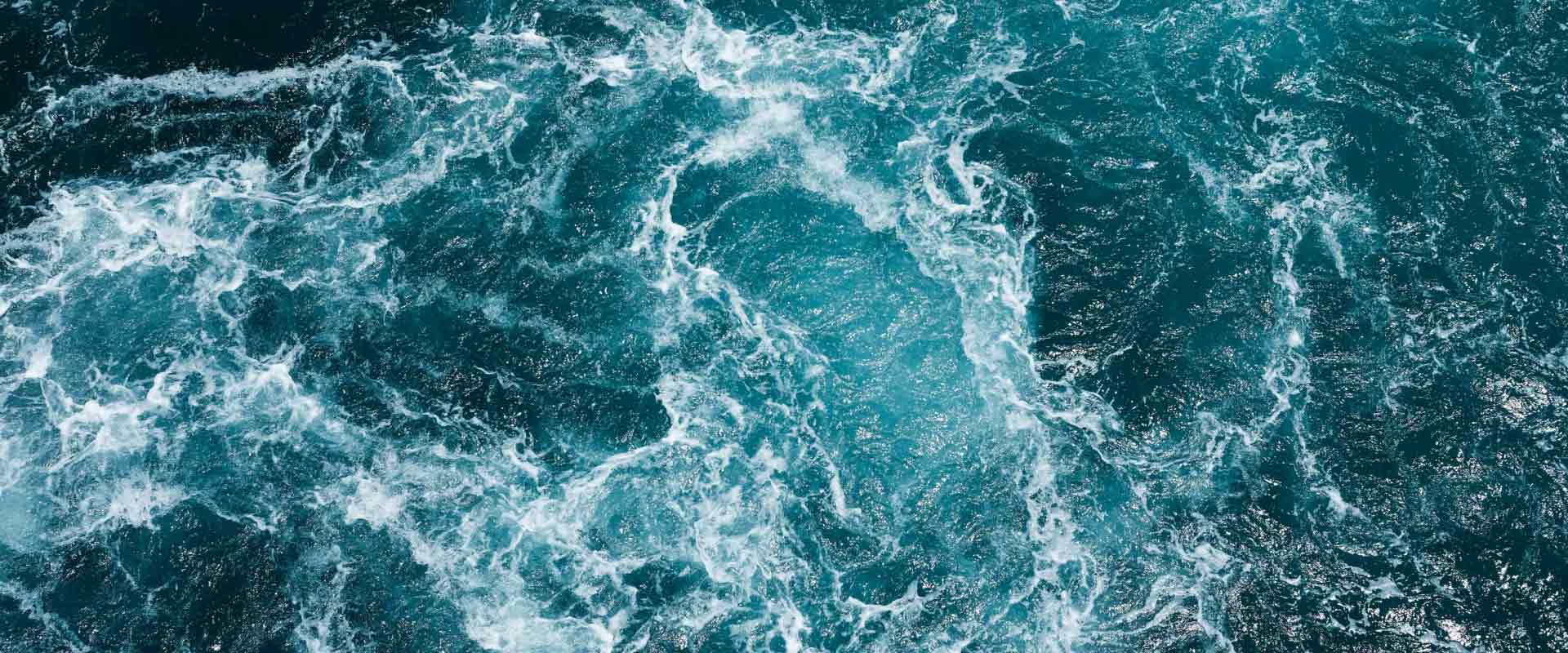
About us
Olson Yacht Group is immensely proud to be the premier dealer for Offshore Yachts, a unique builder whose attention to design and build excellence is remarkable. We’re also the ultimate resource for buyers and sellers of pre-owned Offshores. Our Offshore brokerage sales record is unrivaled. No other company knows the Offshore market and community like Olson Yacht Group! So, if your interest is a new Offshore, a brokerage Offshore, or another yacht brand entirely, make us your first call.

News & blog
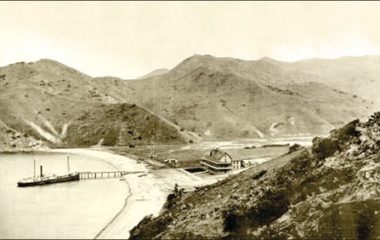
A Not-So-Serious History of Catalina Island
Santa Catalina is a 22-mile long rocky island about 22 miles south-southwest of Los Angeles. It has a resident population of only about 3,700, most of whom live in its only city, Avalon, but over a million tourists drop in for a visit every year. The island is a popular weekend destination for Southern California boaters. In 1958, the Four Preps recorded the famous hit song 26 Miles (Santa Catalina). The song’s composer, Bruce Belland, once said, “It’s really like 22.3 miles, but you try singing that. Think about that meter!”Before all that, though, before hiking permits, golf cart rentals, and mountain bikes with knobby tires, there were the original owners. By the time Spanish explorer Juan Rodriquez Cabrillo “discovered” the island in 1542, the Pimugnan Indians had been there for 500 years. On spotting Cabrillo’s galleon, the Pimugnan paddled out to greet it, and were invited aboard, whereupon gifts and deadly diseases were exchanged with smiles all around. Cabrillo lingered for about 12 hours, shamelessly declared ownership of the island for Spain, thanked the Pimugnan for the fish lunch, and sailed off. Happily for the Pimugnans, another 60 years went by before they were graced with their next visit from Europeans. This time it was another Spanish explorer, Sebastian Vizcaino, who “re-discovered” the island and re-named it Santa Catalina (not that the Pimugnan cared; they continued to refer to their island as Pimu). After 48 hours, Vizcaino had seen enough. Just for good measure, the island was again claimed for Spain, a few more deadly diseases were traded for provisions, and Vizcaino departed, content in the knowledge that Catalina was again secured for the King. Now the Pimugnan were left in peace for almost 30 years. Then in 1769, the Portola expedition arrived, and not having gotten the Cabrillo and Vizcaino memos, Portola once more claimed the island for Spain. This time, however, the Europeans and other visitors never quite went away, and the good old days for the Pimugnan were finito. The Spanish, worried about encroachment by the Russians and British, began colonizing California in earnest, beginning with a franchised chain of missions up and down the coast (no mission was ever built on Catalina). Hoping to evade Spanish trade restrictions, or just seeking a little privacy, smugglers, pirates, and a variety of general all-around scoundrels quickly determined that Catalina’s many hidden coves were just the thing for a all manner of illicit activities. China Point, for instance, was used by smugglers of Chinese immigrants. Oddly, China played another part in the history of the island. Apparently fur hats had become all the rage in China, and as a result, the island was overrun with Russian and Aleut otter hunters from Alaska. Once more, a thriving trade in deadly diseases developed, and in the end neither the otters nor the Pimugnan turned a profit. On the other hand, the Chinese did get their hats. Even today, the only substantial remaining population of sea otters is off the northern Channel Islands. As for the Pimugnan, the few who remained migrated, or were dragged kicking and screaming, to the mainland, where most came under the gentle influence of Mission San Gabriel. Soon, these expatriate Pimugnan were being referred to as Gabrielinos. Today there are no known fluent speakers of the Pimugnan/Gabrielino language. Mexico fought and gained independence from Spanish rule in 1821, and California became a province of the new country. Then, in 1848, following the Mexican-American War, California was snatched up by the United States. After a brief flurry on mining activity, during which gold was hoped for but mere galena (an ore of silver, lead and zinc) was found, Catalina was inhabited mostly by sheep, cattle, and a few herders for about a quarter of a century. Avalon around 1900 — Not a yacht in sight! In 1887, George Shatto, a young businessman from Michigan, bought the island and began developing it as a tourist resort. Selecting a beautiful sheltered valley with a wide, crescent shaped harbor on the northeast side, he surveyed out the town site that would become Avalon. Shatto enlarged an existing wharf to accommodate larger steamers, built the Hotel Metropole, and began selling town lots. Shatto’s sister-in-law, Etta Whitney, chose the town’s name. It came from a Tennyson poem, Idylls of the King, in which a dying King Arthur says that he would be going to Avalon, a beautiful island valley where he would heal himself of his grievous wound. This was all very romantic, of course, but alas, Shatto very unromantically fell behind in his mortgage payments. In 1892 the Banning brothers bought the island. The Bannings built all kinds of attractions, including roads to the interior, the first telephone and wireless telegraph systems, two dance pavilions, an aquarium, a Greek amphitheater, and a golf course. Around this time the island became world-renowned for sport fishing. Elevating fishing from a job to a sport was a new idea, promoted in large part by writer and naturalist Charles Frederick Holder, who popularized the use of light tackle. He also founded Catalina’s Tuna Club, the oldest fishing club in the United States. In 1913, Avalon became an incorporated city. In 1915, about the time all the cityhood excitement had died down, a devastating fire burned out of control for three days, destroying half of the town, including the Hotel Metropole. The Bannings went bust. But, to their credit, they had introduced glass-bottom excursion boats to the island, so they departed with their heads held high. Next, the island came into the enthusiastic hands of William Wrigley Jr., the chewing gum magnate, who bought the island sight unseen but was soon stuck on it (sorry, couldn’t resist). Among other things, William enlarged the fleet of cross-channel steamers, adding the S.S. Avalon and the S.S. Catalina, which he built specifically for the Catalina run. Unlike his predecessors, he didn’t go broke; he did, however, die. And so, in 1932 his son Philip assumed control of the island. Philip enlisted the help of artists Otis and Dorothy Shepard to imbue Avalon with an early California ambiance (that would be Spanish, not Pimugnan, ambiance). Design elements included extensive use of tile, fountains, wrought iron, bell towers, a serpentine wall, soft lighting, and palm and olive trees. Wandering troubadours serenaded wandering tourists. Now we come to that landmark of all Catalina landmarks─the Casino. Prominently visible from land and sea, the round, Art Deco structure rises the equivalent of 12 stories, and is surrounded by water on three sides. Built as a tourist attraction, the Casino’s name derives from the Italian usage of the word meaning “a social gathering place” rather than the Las Vegas lose-your-shirt meaning. The building has never been used as a gambling establishment. The site chosen for the new casino was out at the end of Sugarloaf Point, and at the very tip of the point there was a bullet-shaped rocky outcrop called Sugarloaf Rock (What in the world is a sugarloaf, by the way? Is it a thing shaped like Sugarloaf Rock?). Many people believe that back in the days of the Bannings, Sugarloaf Rock had been blasted away to clear a site for the first casino, Sugarloaf Casino, a mildly impressive octagonal structure used as a ball room and Avalon’s first high school. In fact, old photos of both the original and today’s casino show that they were built adjacent to Sugarloaf Rock, which was removed later on, mostly to improve the ocean view and to provide a level open area at the front of the current casino. The original, smaller Sugarloaf Casino shot from atop Sugarloaf Rock Sugarloaf Casino remained on the site from 1920 to 1928, but eventually the Wrigleys decided it simply wasn’t grand enough and had it razed to make way for today’s casino. Some further blasting was done to create a larger pad for the new building, and by 1929 the casino we all know and love was completed.The Casino houses the Avalon Theater on the first level, which seats up to 1,150, and is the first theater ever designed for sound movies. It is said that the acoustics are so good that a speaker on the stage can speak in a normal voice without a microphone and be heard throughout the room. The ballroom on the second level can accommodate up to 6,000 dancers and is so well insulated that theater patrons directly below cannot hear either the band or the 12,000 dancing feet on the floor above. The new Avalon Casino rises on the site of the old Sugarloaf Casino beside the now defunct Sugarloaf Rock Wrigley designed the Casino with ramps rather than stairs, an idea taken from his experience with Wrigley Field, the Chicago Cubs stadium. The ramps allowed large numbers of people to more efficiently enter and exit (the Chicago Cubs team was also owned by Wrigley, and from 1921 to 1951, excepting the war years, the Cubs used Catalina for spring training) .During World War II, the island was closed to tourists and several branches of the military trained on the island, including the Merchant Marine, Army Signal Corp, OSS, and Coast Guard. When the island reopened after the war, the use of wartime amphibious planes such as the Grumman Goose ushered in a new era of travel to the island. Eventually, both the steamers and flying boats would give way to the helicopters and smaller but faster boats that are used today. Finally, what’s with that bison herd on Catalina? They certainly didn’t hike to the island from South Dakota. The generally accepted explanation is that they were brought to the island in 1924 for the silent film version of Zane Grey’s western tale, The Vanishing American. There’s only one problem─none of the scenes in the movie appear to have been filmed on Catalina. Perhaps the Catalina scenes were cut from the final version, but the island’s absence from the movie does put the history of the bison in doubt. One other oddity─many of the bison aren’t entirely bison; 45 percent have a domesticated cow as an ancestor. Who knew? They all look so bisonish. Here are a few other fun facts: Catalina and its surrounding area are widely known within the UFO community as a “hot spot” for UFO and USO (unidentified submerged object) activity, a reputation enhanced by a famous 1966 video of a “silvery orb” flying low over the backcountry hills of the island. The video is the kind of UFO video we’ve come to expect─a miserably grainy shot of a very distant airborne speck. “Silvery orb” is mostly in the eye of the beholder. In 1936, Ronald Reagan, a young radio announcer for WHO in Des Moines, Iowa, traveled to Catalina to cover the Cubs during spring training. While there, he took a screen test and was offered an acting role. So, if Wrigley hadn’t brought the Cubs to Catalina, Ronny might never have become a movie star, or president for that matter. During World War II, a young Marilyn Monroe briefly lived in Avalon with her first husband, James Dougherty (whose husband status was also brief), a lieutenant in the Merchant Marine. Monroe was often a babysitter for neighborhood children. Today, those former kids have an unbeatable story to tell at cocktail parties. “Marilyn Monroe used to cook my dinner and follow me to bed. No, really, I’m not kidding. Hey, are you calling me a liar! Why, if you weren’t my wife’s brother I’d…” Down through the years, the Wrigley family has clung to its belief that the island should be preserved rather than developed extensively. In 1975 they donated 88% of the island to the Catalina Island Conservancy, a nonprofit corporation dedicated to preserving Catalina in its natural state. The Santa Catalina Island Company, founded by William Wrigley, owns another 11% of the island, and only a skimpy 1% of the real estate is independently owned. As a result, only the city of Avalon is open to the public without restrictions. So, even though the island’s fate is in steady hands, you can’t help but think that the Pimugnans, or Gabrielinos, are still pretty cranky about the way things worked out.
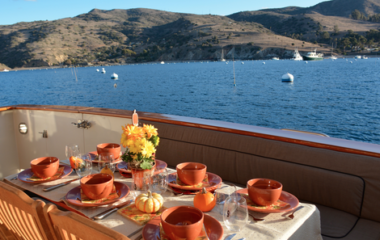
Your Guide to World-Class Cuisine on Your Offshore Yacht
Resource Guide to World-Class Cuisine on Your Offshore Yacht At Offshore West, we know that everything tastes better when it’s cooked and served on your own Offshore Yacht. Whether you’re serving fresh-from-the-sea delicacies like crab, shrimp, or dorado, sizzling chops right off the grill, or a not-so-simple basic cheeseburger, nothing enhances a meal onboard more than the combination of sea air, balmy temperatures, and active outdoor lifestyle on your Offshore Yacht. And whether you’re doing your own cooking or working with a hired chef, the best chefs know that cooking on a boat involves planning, provisioning, and an attention to detail that that few land-based cooks really understand. So, we’ve collected some great resources from the web, along with cookbooks written by boaters and yacht industry chefs with lifetimes of experience, so you can create stunning, unforgettable meals on your Offshore that will have you and your guests raving long after your cruise ends. General Tips for Equipping Your Galley The galley on your Offshore Yacht can be as simple as a motorboat or as sophisticated as any kitchen ashore, depending on your preferences. Follow these tips to keep your galley organized, well-equipped, and ready for anything. The bare minimum of essential equipment for any yacht includes skillets, saucepans, stockpots, and bakeware, as well as a good set of chef knives and magnetic knife rack.Boating and “big box” stores offer a variety of specialty storage solutions including nets, baskets, airtight storage containers, thermal mugs, cups, and beverage servers, as well as silicone bakeware and collapsible containersGiven you’ll be cooking and serving on a moving platform, keep glass in your galley to a minimum. You can find attractive melamine, Lexan, enameled metal, and even acrylic dishware and flatware.Use supplemental coolers for overflow fresh fruits and vegetables, as well as for stocking plenty of beer, wine, and other beverages.The grill on your Offshore Yacht can be supplemented with a variety of add-ons for grilling fish, meats, and virtually anything else you can imagine.Be “ocean friendly” by reducing trash. Use cloth napkins and tablecloths, and reusable, washable flatware. Your Offshore Yacht is the perfect place to use “real” flatware for formal or festive meals. General Tips for Preparing Meals Onboard In general, boat food usually needs to be tasty and easy to eat without requiring lots of utensils or tableware. Hand-held breakfasts (muffins, granola bars, or fresh fruit), “grab and go” lunch sandwiches or tortilla rollups, and simple dinners can provide plenty of exceptional flavor and flair along with basic nutrition.If you’re planning on being away from a port for a week or longer, plan meals around staples like rice, noodles, and grains. Use prepared mixes for sauces, marinades, and garnishes, and customize them (our recommended cookbooks offer tons of ideas).Using your Offshore’ s outdoor grill will keep the interior of your yacht a bit cooler and cut down on generator use. Your grill is perfect for sausages or burgers, veggie brochettes, or chicken wings. Online Resources for Cooking Aboard your Offshore Yacht The Superyacht Chef is a new website for chefs who serve the yachting community all over the world. The blog features articles about high-end galley gadgets, food preparation and presentation techniques, stellar recipes shared by superyacht chefs all over the world, and recommended cookbooks for the yacht galley. They even link to agencies that will help you find a professional yacht chef, if that suits your style. Portside Cuisine is the website of Peg Donahue, a former chef aboard both private and charter yachts, where she cooked for scores of interesting, influential people (like you!) including high profile politicians, writers, scientists, and even movie stars. Working as a chef for nearly 10 years aboard yachts ranging from a 26 to 90 feet, she cruised throughout the Caribbean, along the coast of Venezuela, the Eastern seaboard of the United States, and as far north as the border of Nova Scotia. Her website features recipes (complete with photographs good enough to eat all by themselves), equipment tips and recommendations, and stories of her travels and the fascinating people and places she’s encountered along the way. We offer a review of her cookbook of the same name below. The Boat Galley offers hundreds of recipes that include a wealth of options for dietary and equipment restrictions. From the website: “Cooking on a boat is different, but boat-friendly recipes make great meals on your cruising adventures not just possible but easy.” Some specialty recipes include: Recipes to grill everything from vegetables to meat and chicken to fresh-caught fishMake-ahead meals for longer passages or weekends out on your OffshoreSpecialty recipes for dairy-free, gluten-free, keto, or other restricted mealsTips to make your own seasoning mixes for use in other recipes In addition to the website, there are bite-sized bits of information, 5 to 10 minutes long, offered in The Boat Galley Podcast | The Boat Galley,by Nica Waters and Lin Pardey. The podcasts offer a nice alternative to browsing over 1200 articles on the website itself. All Recipes is a great online source of tested recipes for every occasion, and their “Galley Kitchen” section offers a wealth of insight into using space wisely, equipping your galley, meal planning and tips for quick, efficient, and safe cooking in a small, moving space. Recommended Yachting Cookbooks for your Offshore Library The following nautical cookbooks are highly recommended (available on Amazon) and grace the galleys of many yacht chefs as well as full-time liveaboards and weekend cruisers. The Portside Cuisine Cookbook: A Yacht Chef’s Recipe Collection by Peg Donahue From Peg’s press release: “With stunning food photography and more than 160 individual recipes, The Portside Cuisine Cookbook reveals a glimpse behind the galley doors of a professional charter chef as she creates world-class cuisine on the high seas for clients that range from everyday guests to captains of industry and celebrities of the silver screen.” She also shares interesting short stories behind each recipe that are so exciting, entertaining, and educational that you can imagine each dish elegantly presented and served on your own Offshore Yacht. Her recipes are easy-to-use, family tested, and suitable for budding cooks as well as professional chefs, and range from simple “comfort food” to elegant and elaborate meals for holidays, formal dinners, buffets, picnics, and any kind of party you can imagine. She includes vegetarian recipes as well as those that are easily adaptable to accommodate dietary restrictions. Every recipe lists nutritional information for those who need to monitor salt, sugar, or calorie intake. Cruising Chef Cookbook, by Michael Greenwald After 22 years in print, now in its 10th printing, the Cruising Chef Cookbook is essential to any boat galley. Not only are there more than 300 delicious recipes, there are hundreds of tips for buying, storing, provisioning, and resupplying in out-of-the-way markets. Greenwald also offers extensive instruction on special cooking techniques like pressure-cooking, stir-frying, and grilling. But perhaps the highlight of this cookbook is the salty humor that seasons the chapters. Articles like “Planning for the Big Eater” and “Fishing” will leave you exhausted from laughing out loud. The Boat Galley Cookbook: 800 Everyday Recipes and Essential Tips for Cooking Aboard, by Carolyn Shearlock and Jan Irons In this easy-to-navigate and extensively cross-referenced masterpiece, long-term liveaboard cruisers Carolyn Shearlock and Jan Irons offer more than 800 recipes made from easily found ingredients and hand utensils in small boat galleys. In addition to their personally galley-tested recipes, they offer unique energy-saving tips like cooking in a Thermos, baking on top of the stove, and preparing enjoyable meals in a tiny, moving kitchen. The Boater’s Cookbook: 450 Quick & Easy Galley-Tested Recipes, by Sylvia Williams Dabney Dabney, a long-time live-aboard cruiser has over sixty thousand miles under her belt, and understands not only the necessity of a well-stocked pantry but the joy of collecting recipes from all over the world. A highlight of this wonderful cookbook is the comprehensive list of the kinds of gadgets gear, and supplies that every boater needs – and how to store it all in a limited space, whether it’s a 27-foot sailboat or a 60-foot motor cruiser. When you’re next out on your Offshore, remember that dining aboard is one of the rare joys of boating. We’d love to hear about your recommendations for shopping, storing, or cooking aboard your own Offshore Yacht. We’d also be delighted to share your recipes, grilling tips, and menu plans with the rest of our Offshore family. Just drop us a line or give us a call at either our Newport Beach Fort or Lauderdale office. We’ll look forward to hearing from you.

William “Bill” Luther, Naval Architect, receives Lifetime Achievement Award
Lifetime Achievement Award Naval Architect William “Bill” B. Luther has been a partner with Offshore Yachts for many years. Bill worked side by side with the great Naval Architect William I.B. Crealock. We want to give a “shout-out” as Bill was honored by the Maritime Institute not only for his work as a Naval Architect but more importantly for his great character and generosity toward at risk youth. On December 14, 2019 at the Los Angeles Maritime Institute’s annual Christmas and Award Ceremony, Executive Director, Captain Bruce Heyman and Captain Alice Robinson presented Naval Architect, William B. Luther a “Lifetime Achievement Award.” He was presented with #1 print (of 200) of a watercolor titled “Rendezvous At Angel’s Gate, Twin Brigantines, Exy Johnson and Irving Johnson.” The painting, painted by Scott Kennedy, also includes a remarque in the corner titled “ To Adventure at sea and the kids” a nod to the great work done by L.A.M.I. in its efforts to help children at risk. Bill has been a part of that program since its inception. He is L.A.M.I.’s Naval Architect and continues to work with them on ongoing projects. We at Offshore West also want to say Thank you Bill!!! Well Done!!!
